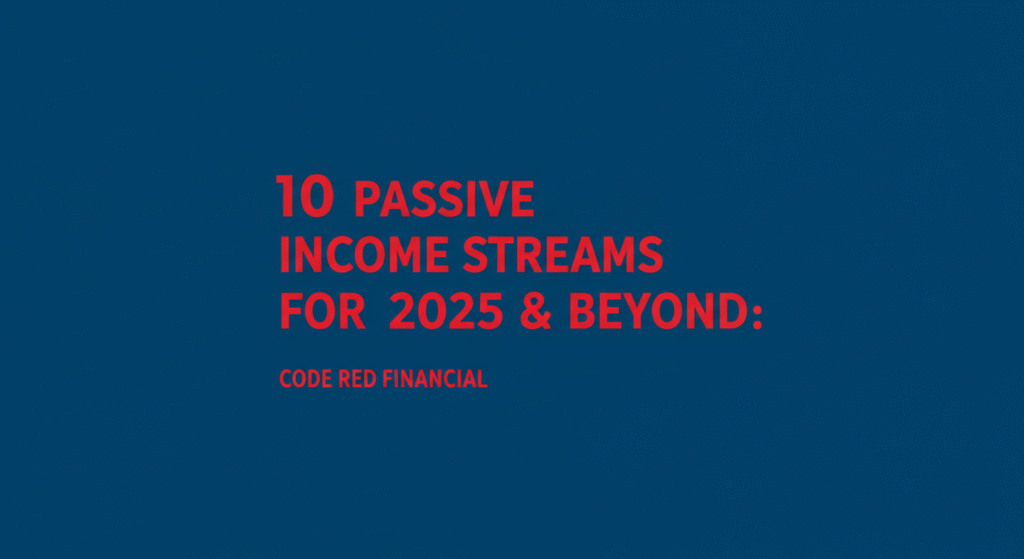
Beyond the Daily Grind:
Let’s be honest. The traditional path of trading time for money is feeling… well, old-fashioned. In an economy that’s constantly shifting, where the only constant is change, relying solely on a single paycheck feels increasingly precarious. What if you could build streams of income that flow whether you’re actively working or not? That’s the magic of passive income, and it’s not a myth reserved for the ultra-wealthy. It’s a tangible goal, and with the right approach, you can start building your future financial freedom today, setting yourself up for 2025 and the unpredictable years that follow.
Passive income isn’t about getting rich quick with zero effort. Let’s bust that myth right now. It almost always requires significant upfront time, effort, or capital to set up and nurture. But once established, the ongoing work is minimal compared to the income generated. Think of it like planting a tree – you do the hard work of digging, planting, and initial watering, but then it grows and provides fruit (or shade, or beauty) for years with just occasional care.
Why is this so crucial for 2025 and beyond? The world is accelerating. Technology is automating tasks, the gig economy is evolving, and traditional career paths are less linear than ever before. Building passive income isn’t just about making extra money; it’s about creating resilience, gaining control over your time, and opening up possibilities you never thought possible. Imagine having the flexibility to travel, spend more time with loved ones, pursue a passion project, or simply weather unexpected financial storms without panic. That’s the power we’re talking about.
Ready to explore the possibilities? Here are 10 passive income streams that hold significant potential for 2025 and the future, and why you should seriously consider starting to plant those seeds today.
1. Dividend Investing: Becoming a Part-Owner of Profit Machines
Imagine owning a piece of the world’s most successful companies and getting paid simply because they make money. That’s the essence of dividend investing. When you buy stocks in dividend-paying companies, you become a shareholder, and these companies regularly distribute a portion of their profits to shareholders in the form of dividends. This can be a powerful, truly passive income stream once your initial investment is made.
For 2025 and beyond, dividend investing remains a cornerstone of passive income for many investors. Companies with a history of consistent dividend payments (often called “Dividend Aristocrats” or “Dividend Kings”) are particularly attractive for their reliability. The key here is research and diversification. Instead of putting all your eggs in one basket, you can invest in a variety of dividend-paying stocks across different sectors or utilize dividend-focused Exchange Traded Funds (ETFs) and mutual funds for instant diversification.
Getting started today is accessible, even with a modest amount of capital. Online brokerage platforms have made buying stocks easier than ever. You can set up automatic dividend reinvestment plans (DRIPs), which use your dividends to buy more shares, compounding your earnings over time. While stock values can fluctuate, the goal with dividend investing for passive income is the regular cash payout, providing a consistent stream separate from market ups and downs. The market outlook for reliable dividend stocks remains positive for income generation, particularly for those focused on long-term holds.
2. Real Estate Crowdfunding & REITs: Earn Rental Income Without the Landlord Headaches
Owning physical rental property is a classic way to earn passive income, but it often comes with significant active responsibilities: finding tenants, handling maintenance, dealing with vacancies, etc. For a more hands-off approach, especially looking towards the future, real estate crowdfunding and Real Estate Investment Trusts (REITs) offer compelling alternatives.
Real estate crowdfunding platforms allow you to invest in larger real estate projects (like apartment buildings, commercial properties, or development loans) alongside other investors. You pool your money, and professional real estate firms manage the properties or projects. You earn income from rent or loan interest, proportional to your investment, without the day-to-day hassles of being a landlord. This sector is seeing continued growth and innovation, making it increasingly accessible for individual investors in 2025 and beyond.
REITs are companies that own, operate, or finance income-generating real estate. They are often publicly traded, like stocks, and are required to distribute a large percentage of their taxable income to shareholders as dividends. Investing in REITs is similar to buying stocks but focused specifically on the real estate market. This allows you to gain exposure to diverse real estate portfolios (malls, hotels, office buildings, residential properties) without directly buying, managing, or financing properties yourself. Both crowdfunding and REITs offer pathways to real estate income that are more passive than traditional ownership and are expected to remain strong avenues for passive income into the future.
3. Creating and Selling Digital Products: Your Knowledge, Their Value
Got a skill, expertise, or creative talent? Turn it into a digital product! Ebooks, online courses, templates, software, music, graphic designs, stock photos, and more can be created once and sold repeatedly, generating income while you sleep. The demand for digital content and resources is only growing, making this a highly relevant passive income stream for 2025 and well into the future.
The initial effort here is in creation. Writing an ebook, filming a course, or designing templates takes time and expertise. However, once the product is complete and listed on platforms like Amazon Kindle Direct Publishing, Udemy, Skillshare, Etsy, Gumroad, or your own website, it can generate sales passively. Marketing and promotion are necessary upfront and periodically, but the core work of creation is a one-time effort.
The beauty of digital products lies in their scalability and low overheads. There are no manufacturing costs, no inventory to manage, and delivery is instant. As consumer habits continue to shift towards online learning and digital consumption, creating valuable digital products offers a powerful way to build a passive income stream that can thrive in the coming years. Starting today means identifying your niche and getting to work on that first valuable piece of digital content.

4. Affiliate Marketing Through Content Creation: Recommending What You Love
Affiliate marketing involves promoting other companies’ products or services and earning a commission on sales made through your unique affiliate link. While you can do this actively through paid ads, the passive income stream comes from creating content (like blog posts, YouTube videos, podcasts, or social media reviews) that naturally includes affiliate recommendations.
Once your content is published and ranking in search engines or discovered by your audience, it can continue to generate clicks and sales long after you’ve created it. The key to passive affiliate marketing is building an audience around a specific niche and providing genuine value. If people trust your recommendations because your content is helpful, informative, or entertaining, they are more likely to click your links.
Success in affiliate marketing for 2025 and beyond hinges on building authority and evergreen content – content that remains relevant over time. While initial content creation and audience building require significant effort, a well-established blog or YouTube channel with valuable, affiliate-linked content can become a substantial passive income engine. The trend towards content consumption means opportunities here are abundant, provided you focus on authenticity and value.
5. Rental Properties (Made More Passive): Strategic Ownership
Yes, traditional rental properties can be made more passive with the right strategies, making them viable for 2025. While not as hands-off as REITs or crowdfunding, direct ownership offers control and potential for significant appreciation.
The key to making rental properties passive lies in outsourcing management. Hiring a reliable property management company can handle everything from tenant screening and lease agreements to rent collection, maintenance, and repairs. Your role becomes one of an investor overseeing the manager, rather than a hands-on landlord.
While this reduces the time commitment significantly, it’s important to factor in management fees and the occasional need for major repairs or decisions. However, with careful property selection in areas with strong rental demand and appreciation potential, rental properties can generate consistent monthly cash flow and build long-term wealth. Looking ahead, the demand for rental housing is likely to remain strong in many markets, making this a durable passive income strategy if approached strategically.
6. Peer-to-Peer (P2P) Lending: Playing the Bank (Carefully)
P2P lending platforms connect individuals who want to lend money with individuals or small businesses who want to borrow. As a lender, you can invest relatively small amounts across many different loans, diversifying your risk. You earn passive income from the interest payments made by the borrowers.
The appeal of P2P lending is the potential for higher returns compared to traditional savings accounts or bonds. However, it’s not without risk, as borrowers can default on their loans. Platforms mitigate this risk by providing credit assessments and allowing diversification, but it’s crucial to understand the potential for loss.
As the fintech landscape evolves towards 2025, P2P lending platforms continue to refine their models and risk assessment tools. For those comfortable with a certain level of risk, allocating a portion of their portfolio to P2P lending can provide a consistent stream of interest income. Starting today involves researching reputable platforms and understanding their risk profiles and loan types.
7. Licensing Royalties: Earning from Your Creations
If you’re a musician, photographer, videographer, artist, or inventor, you can potentially earn passive income through licensing your work. This means allowing others to use your creation in exchange for a fee or ongoing royalties.
For photographers and videographers, selling stock photos and footage on platforms like Shutterstock or Adobe Stock can generate royalties each time your work is downloaded. Musicians can earn royalties when their music is streamed, played on the radio, or used in films and commercials. Artists can license their designs for use on products. Inventors can license their patents.
While creating the initial work requires active effort, once it’s licensed, it can generate income repeatedly. The key is creating high-quality, in-demand work and getting it onto the right platforms or in front of the right people. As digital content consumption and creative industries continue to grow, the opportunities for licensing royalties are expected to remain robust. Starting today means exploring platforms relevant to your creative field and understanding how licensing works.

8. Building and Monetizing Niche Websites: Your Digital Real Estate
Creating a website focused on a specific, narrow topic (a “niche”) and monetizing it through advertising, affiliate marketing, or selling your own products can become a significant passive income stream.
This requires upfront work in building the website, creating valuable content (articles, reviews, guides), and optimizing it for search engines (SEO) to attract organic traffic. Once the website is established and attracting visitors, you can earn money passively through display advertising (like Google AdSense), affiliate commissions from recommending products, or even selling digital products you create.
While ongoing maintenance and content updates are often necessary to keep the site relevant and ranking, the bulk of the income can be generated passively from the existing content and traffic. The market for niche content remains strong, with opportunities in countless areas of interest. Building a niche website today requires identifying a profitable niche, creating high-quality content, and committing to the initial growth phase.
9. Automated Dropshipping Store: E-commerce with Less Overhead
Dropshipping is an e-commerce model where you sell products online without holding any inventory. When a customer places an order on your store, you purchase the item from a third-party supplier (often in China) who then ships it directly to the customer. Your profit is the difference between your selling price and the supplier’s cost.
While setting up a dropshipping store, finding reliable suppliers, and marketing products requires significant upfront effort, aspects can be automated. Order processing, customer service (to a degree), and even marketing can be streamlined or outsourced, making it a more passive operation over time.
The dropshipping landscape is constantly evolving, with trends pointing towards focusing on specific niches and building a strong brand to stand out. For 2025 and beyond, success will likely require a strategic approach to product selection and marketing. Starting today involves researching niches, finding suppliers, and setting up your online store, with a focus on building systems that can eventually run with minimal intervention.
10. Cryptocurrency Staking & Yield Farming: Earning from Digital Assets
For those comfortable with the volatile world of cryptocurrency, staking and yield farming offer ways to earn passive income from your digital assets. Staking involves holding certain cryptocurrencies in a wallet to support the network’s operations, and in return, you earn rewards (more crypto). Yield farming involves lending or “locking up” cryptocurrency in decentralized finance (DeFi) protocols to earn interest or other rewards.
These methods can offer high potential returns, but they also come with significant risks, including market volatility, smart contract vulnerabilities, and impermanent loss in yield farming. It is absolutely crucial to thoroughly understand the technology and risks involved before participating.
As the cryptocurrency space matures, staking and yield farming are becoming more accessible through various platforms and exchanges. However, this remains a higher-risk passive income stream compared to traditional investments. For 2025 and beyond, navigating this space successfully will require careful research, risk management, and staying informed about the rapidly changing landscape. Starting today means educating yourself extensively on the specific cryptocurrencies and platforms you are considering.
The Path Forward: Starting Today
Building passive income streams isn’t a sprint; it’s a marathon. Each of these avenues requires some level of upfront investment – be it time, money, or expertise. The key to success for 2025 and beyond is starting today. Don’t wait for the perfect moment or until you have a massive amount of capital.
- Start small: You don’t need to build a massive website or buy an entire apartment complex overnight. Begin with one stream that resonates with you and fits your current resources. Invest a small amount in dividend stocks or REITs, create your first digital product, or start researching your niche website idea.
- Be consistent: Passive income builds over time. Consistent effort in creating content, adding to your investments, or refining your systems is crucial for long-term growth.
- Diversify (eventually): Once you have one stream flowing, consider building another. Diversification helps mitigate risk and creates multiple sources of financial resilience.
- Educate yourself: The world of passive income is constantly evolving. Stay informed about trends, strategies, and potential pitfalls in the streams you pursue.
- Be patient: Passive income takes time to generate significant returns. There will be upfront work and potentially slow beginnings. Stay committed and focus on the long-term vision.
Listen, we all know just how uncertain the future appears at times, but that doesn’t mean that we are relegated to only embrace or be entirely dependent on a single active income source. By exploring and implementing these passive income streams, starting today, you can build a more secure, flexible, and abundant financial life for 2025 and the many years that follow. It is important to remember that the power to create financial freedom is within reach – you just have to decide to start planting those seeds now to have a bountiful harvest in the future.
Disclaimer: This article is for informational purposes only and should not be considered financial or investment advice. Investing in any of the mentioned passive income streams involves risk, and you could lose money. Before making any investment decisions, it is essential to conduct your own thorough research and consider consulting with a qualified financial advisor who can assess your individual financial situation, risk tolerance, and goals. The potential returns discussed are illustrative and not guaranteed. Market conditions, regulations, and other factors can significantly impact the performance of any investment or business venture.





